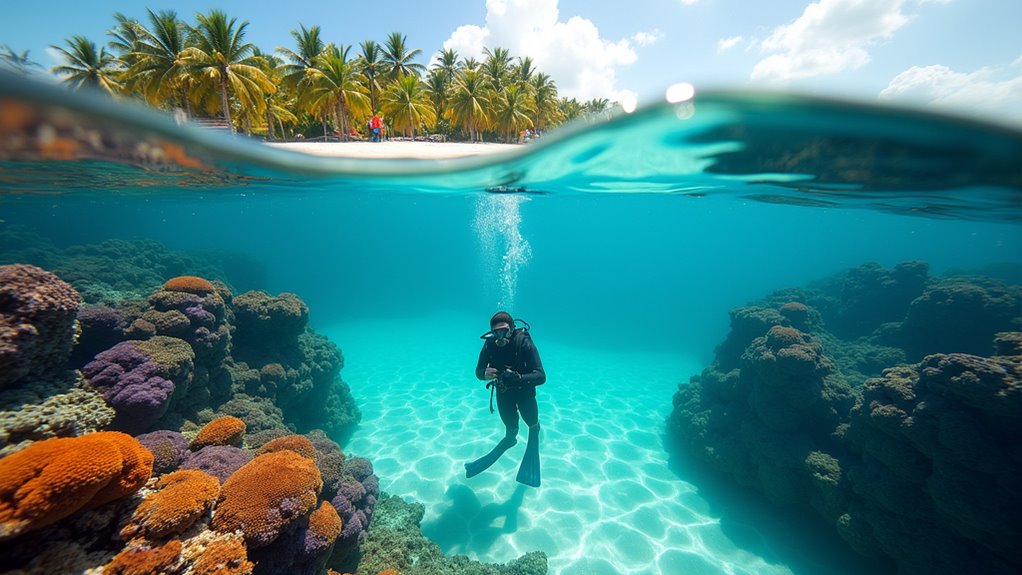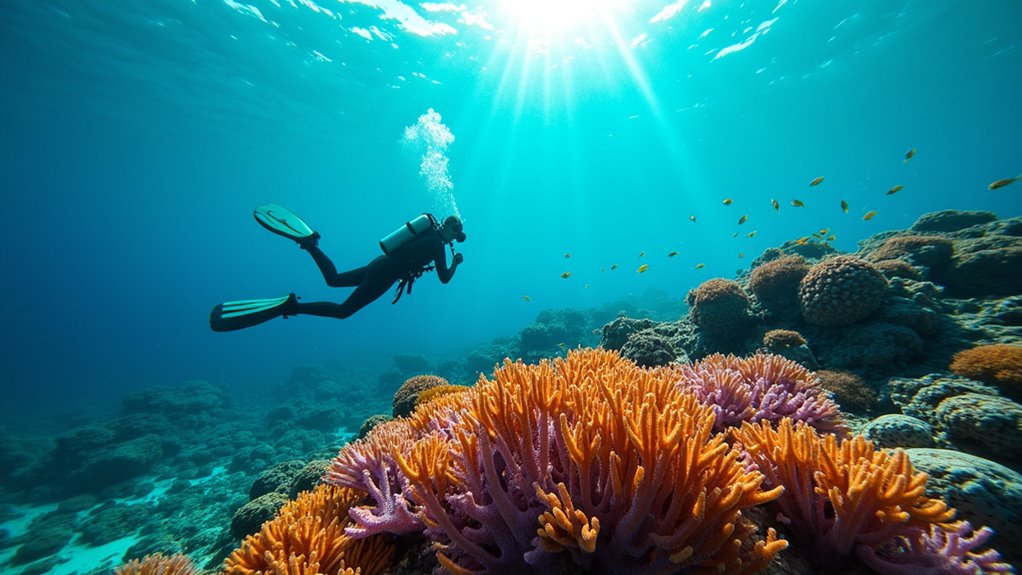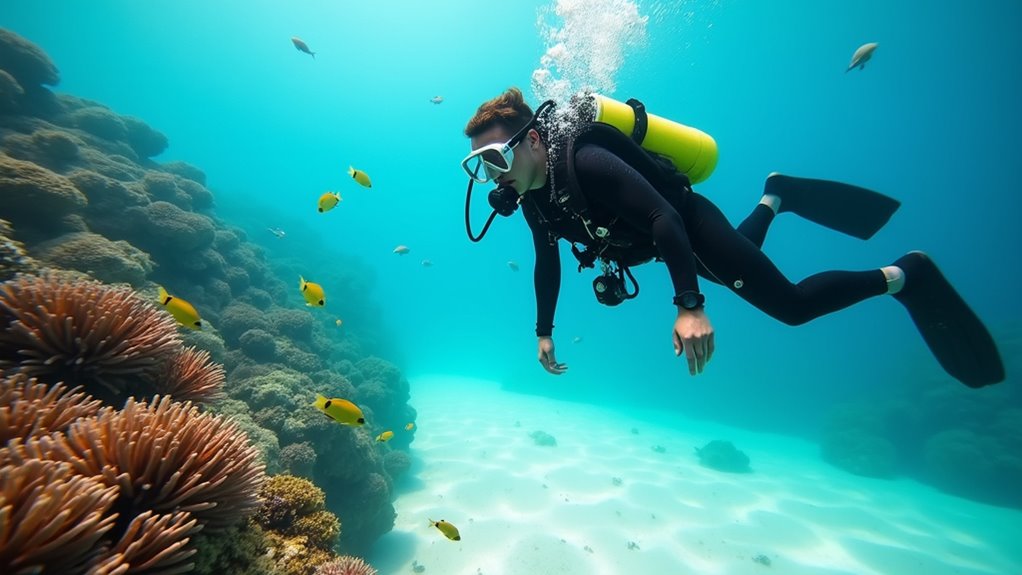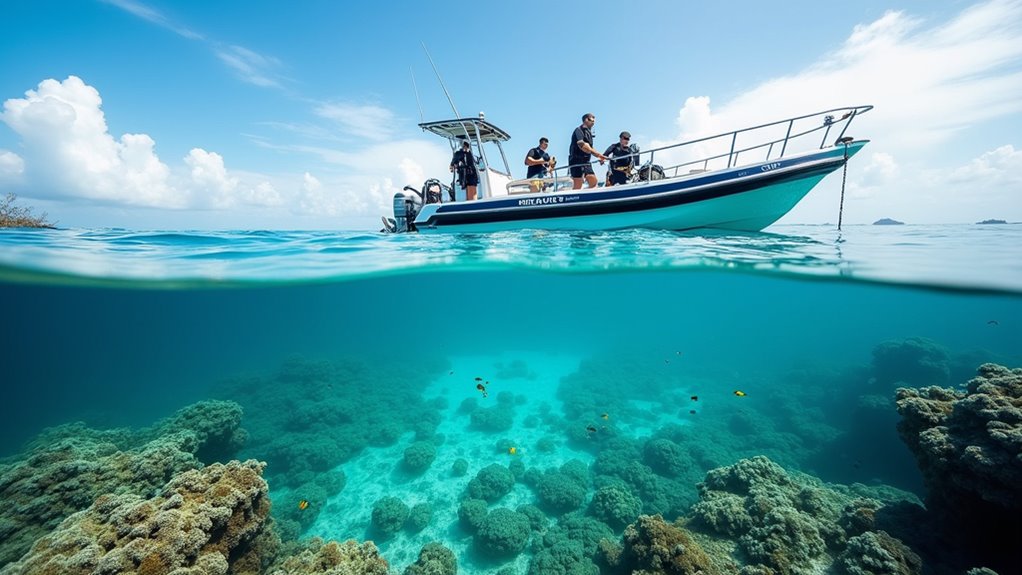Physical Address
304 North Cardinal St.
Dorchester Center, MA 02124
Physical Address
304 North Cardinal St.
Dorchester Center, MA 02124

Hidden beneath Boracay's tourist crowds lie 20+ pristine dive sites with sea turtles and coral gardens—but which spots offer the best value?
You probably don’t realize that Boracay’s underwater world rivals its famous white sand beaches, with over 20 dive sites scattered around the island’s pristine waters. While most visitors stick to the surface attractions, you’re missing out on vibrant coral gardens, friendly sea turtles, and macro photography opportunities that won’t break your travel budget. The real question isn’t whether you should dive here, but how to maximize your underwater experience without overspending on gear and tours.

When you’re planning your Boracay diving adventure, timing can make or break your underwater experience. You’ll find the best diving conditions from November through May during the dry season. The water’s calmest, visibility reaches 15-30 meters, and you won’t deal with strong currents or choppy seas.
Avoid June through October – that’s monsoon season. Heavy rains, rough waters, and poor visibility make diving challenging and potentially dangerous. Many dive shops actually close during these months, so you’d have limited options anyway.
March through April offers the sweet spot with perfect weather and fewer crowds, meaning better dive deals. Water temperature stays comfortable year-round at 26-28°C, so you won’t need thick wetsuits. Book your dives during dry season mornings when conditions are typically most stable. Consider planning your diving trip as part of a romantic getaway, as the island offers plenty of camping activities that couples can enjoy together between dive sessions.
Once you’ve timed your visit right, you’ll want to know where to actually get in the water. Crocodile Island sits just offshore from Station 1 and offers the most accessible diving for beginners. You’ll find colorful coral gardens at shallow depths without breaking your budget on boat transfers.
Angol Point delivers more challenging dives with stronger currents, but rewards you with larger fish and better visibility. The site’s perfect for intermediate divers seeking variety.
Crystal Cove provides budget-friendly snorkeling and shallow diving opportunities right from the beach. You won’t need expensive boat rides here.
Tambisaan Beach offers calm conditions and affordable local dive operators. It’s your best bet for cheap certification courses and practice dives before tackling Boracay’s more demanding underwater sites.
For those looking to explore the island further, consider renting an RV to easily access remote diving spots and camping areas around Boracay’s coastline.

Where exactly will you spot the most marine life without spending a fortune on specialized dive trips? You’ll find plenty of affordable underwater action right off Boracay’s accessible shore sites.
At Crocodile Island, you’ll encounter schools of sergeant majors, parrotfish, and angelfish darting between coral formations. Don’t miss the resident sea turtles that frequently cruise these waters—they’re surprisingly approachable.
Tambisaan Beach offers budget-friendly diving where you’ll spot moray eels hiding in crevices and colorful nudibranchs decorating the coral walls. Keep your eyes peeled for octopuses camouflaged against rocks and trumpet fish hovering vertically near sea fans.
While you won’t find large pelagics here, the diversity of smaller reef fish, crustaceans, and macro life makes every dive worthwhile without breaking your budget. Consider whether renting or buying a boat would be more cost-effective for multiple diving excursions around the island’s various dive sites.
If you’re new to diving or need to upgrade your certification, Boracay’s dive shops offer extensive training programs that won’t drain your wallet. You’ll find PADI and SSI courses starting around $300 for Open Water certification, which includes theory sessions, pool training, and four open water dives.
Most shops provide equipment rentals as part of their packages, saving you hundreds on gear purchases.
Advanced courses like Rescue Diver or specialty certifications cost between $150-250 each.
Popular dive centers like Victory Divers and Fisheye Divers maintain high safety standards while keeping prices competitive. They’ll often throw in free fun dives or discounts on future trips when you complete your certification with them.
Book during off-peak months for additional savings on course fees. Don’t forget to pack essential camping gadgets like waterproof gear organizers and portable power banks to keep your diving equipment dry and devices charged between underwater adventures.

While most dive shops provide basic rental equipment, bringing your own essential gear can guarantee a comfortable underwater experience. You’ll want to prioritize a well-fitting mask and snorkel – these items are personal and directly affect your comfort underwater.
Consider packing your own fins if you have specific preferences, though rental options work fine for most divers.
A dive computer isn’t essential but helps track your depth and bottom time independently.
Don’t forget reef-safe sunscreen to protect yourself between dives without harming Boracay’s coral reefs.
Most shops provide BCDs, regulators, and tanks, so you won’t need to transport heavy equipment.
However, bringing a mesh bag for collecting shells or trash keeps your hands free while diving and helps protect the marine environment.
Just as Scotland’s West Highland Way offers some of the world’s most breathtaking hiking experiences, Boracay’s underwater trails provide equally stunning adventures beneath the waves.
Although Boracay’s crystal-clear waters invite exploration, you’ll need to follow essential safety protocols to make certain your underwater adventures remain memorable for the right reasons.
Never dive alone – buddy systems aren’t just recommendations, they’re lifelines. Check your gear twice before entering water, focusing on regulator function and air supply. Stay within your certification limits; advanced sites require advanced skills, not wishful thinking.
Monitor your air gauge constantly, surfacing with at least 500 PSI remaining. Ascend slowly – rushing up causes decompression sickness that’ll ruin your vacation and drain your wallet.
Respect local marine life by maintaining distance from coral reefs and fish. Strong currents around Boracay can surprise inexperienced divers, so inform dive masters about your skill level honestly.
Weather changes quickly; don’t dive during storms or rough seas. Many diving accidents stem from common mistakes that are entirely preventable with proper preparation and adherence to safety protocols.

Beyond following safety protocols, your underwater experience depends heavily on selecting reputable operators who prioritize both your safety and budget. Research dive shops beforehand by checking online reviews and certifications. Look for PADI or SSI-certified instructors and well-maintained equipment.
Compare package prices, but don’t choose based solely on cost. Cheaper operators often cut corners on safety or equipment quality. Ask about group sizes – smaller groups mean more personalized attention and better value.
Check what’s included: equipment rental, lunch, transportation, and certification fees can add up quickly. Some operators offer combo packages with snorkeling or island hopping that maximize your budget.
Visit shops in person to assess their professionalism. Clean facilities, organized equipment, and knowledgeable staff indicate quality operations worth your investment. Just like planning any family adventure, thorough preparation and research will ensure you select the best diving experience for your group’s needs and skill levels.
With over 20 dive sites within a 30-minute boat ride from shore, you’ll never run out of underwater adventures in Boracay. You can explore multiple spots without breaking the bank, especially when you book package deals during off-peak months. Don’t forget to factor in certification costs if you’re new to diving – it’s worth the investment for accessing Boracay’s deeper, more spectacular sites. Your underwater memories here will last a lifetime.